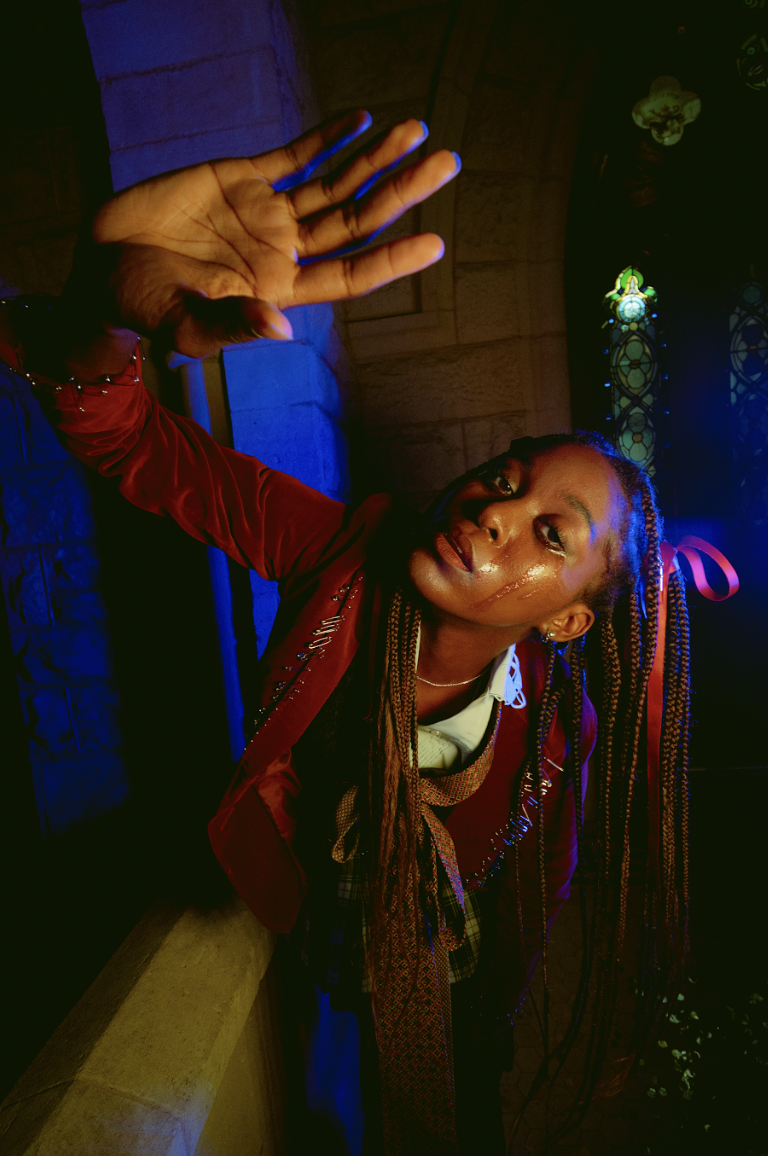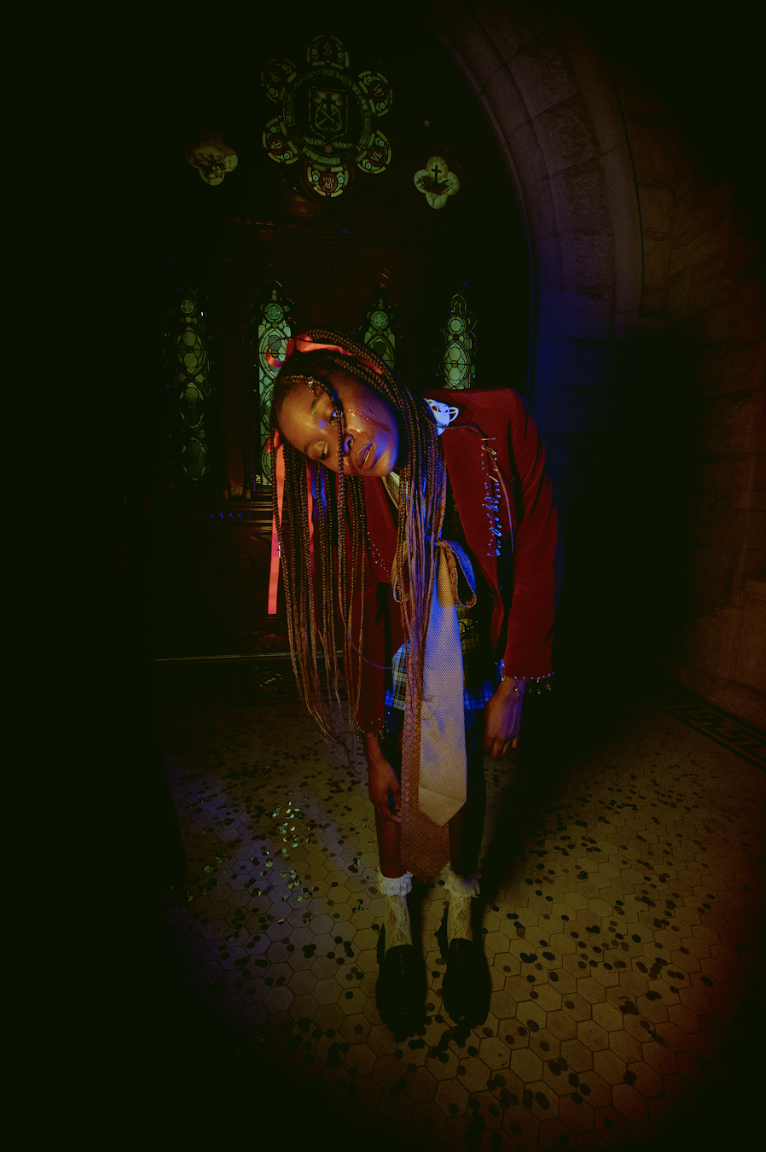|
Plaid Skirts and the Sin of Self-Expression |
By Ellen Daly
May 1, 2022

Photo by Ren Breach
In Catholic school, I preferred anonymity to eternal damnation.
I spent the first eighteen years of my life draped in plaid.
Some of my earliest and fondest childhood memories are of piling out of my neighbors’ mom’s Chevy Suburban in a swarm of six other kids, all of us pulling at the buttons on our waists and throwing our plaid Catholic-school uniform dresses (called “jumpers”) over our heads. We’d wave them around like flags, toss them into the sun-soaked grass, and bask in our after-school freedom: running and jumping and cartwheeling and doing all the things kids can do and should.
Your whole body felt lighter after taking that thing off. The item itself wasn’t particularly heavy, but a thick fabric hanging all day from a single-digit-years-old body takes its toll. For the first time all day, you could feel your skin separate from your white button-down shirt. There was a breeze under your armpits! You could see your knees! After eight hours of being cloaked in camouflage, you started to feel like yourself again.
In the early years, my jumper served as a straitjacket of sorts. I wasn’t an unruly child, but I was certainly spunky: my mom recalls that as a toddler I wouldn’t allow her to pick out my outfits for daycare, insisting instead that I style myself. With the loss of this creative outlet due to my wearing uniforms came the surrender of my strong-willed spirit. In school I was quiet and well-behaved, careful to not disturb the teacher-student hierarchy. Without the tools of dress, students learned to distinguish themselves through acts of rebellion and disruption. I affiliated disciplinary action with divine retribution, and I preferred anonymity to eternal damnation, so I stuck with that. My jumper became multipurpose: straitjacket and invisibility cloak.
Those blissful afternoons spent in my or my neighbor’s front yard were their own Dionysian festivals. We’d write songs, choreograph dances, and reenact scenes from our favorite TV shows. As children tend to be, we were innately artistic and expressive. Rid of the cloth of discipline and order, of raising your hand to speak, of holding your hands behind your back as you walked in a straight line down the hall, of “the quiet game” and being “quiet as church mice,” of sitting boy-girl-boy-girl order at prayer services and confessing your sins to an old man in a dark room, we could just be.
~
O my God, I am heartily sorry for having offended You, and I detest all my sins because of Your just punishments, but most of all because they offend You, my God, who are all good and deserving of all my love. I firmly resolve with the help of Your grace to sin no more and to avoid the near occasion of sin. Amen.
~
As I grew older, my plaid became an instrument of bodily surveillance. I recall a sunny afternoon in fifth grade: my neighbor and I were sitting on the curb in the parking lot after school waiting for one of our moms to pick us up. I sat with my legs extended, ankles crossed, and my neighbor sat with her knees bent, butt on the curb and feet on the ground. “Don’t sit like that!” our teacher scolded her. “I can see up your skirt.”
To possess a female body, I learned, is to be observed. It requires that the owner of the body exist in a constant state of self-observation. Your once free, childlike movements become restrained.
Don’t sit like that, you learn to tell yourself.
Don’t bend over—squat.
Keep your knees together.
Keep your legs crossed.
Never, ever let anyone see what’s under there.
In middle school, the teacher would call all the girls in the class to the front of the room to line up and kneel on the floor. If your skirt did not touch the floor, you received a dress code violation, which was reported to your parents. Any particularly outspoken girls who questioned the system were assured that the boys were equally oppressed, as they received “haircut checks” to ensure that the hair on their heads did not touch their ears. As children, we lacked the ability to recognize our sexualization, so that was that. Girls got skirt checks, and boys got haircuts.
I received my first and only detention during my freshman year of high school for, of course, my skirt length. My mom was always prudent in ensuring that my skirt abided by the school’s guidelines, but, in an attempt to prove herself as some sort of disciplinarian, my freshman year Spanish teacher held a sweeping skirt check in which all but one girl in my class received a detention. My skirt, which was maybe half an inch off the ground when I kneeled, did not make the cut. A good stoic Catholic child, taught not to weep but to repent, I kept my composure for the rest of the school day. Then, I went home and cried.

Photo by Ren Breach
It wasn’t until college that I learned to dress myself again. Somehow, the toddler within who insisted she style herself for daycare was still there, and every day was the royal ball. During my freshman year, I curated a closet of clothes I would’ve never worn in my school years: I never had the time and space to explore that side of myself. I wore brightly colored makeup, dyed my hair blue, and bought low-cut tops and short skirts just because I could. I mixed wild prints, funky hats, and mismatched patterns because it was fun. I discovered this part of me that was playful, flamboyant, and expressive, and it saddens me that I didn’t get to grow up with her. The woman I know now is far bolder and more imaginative than my younger self who was forcefully draped in plaid. For this freedom I am grateful, and now, more than ever, I resent that restraint.
It’s Friday night, and I’m getting ready to go out with some friends. We’re doing what we usually do to unwind at the end of a long school week: get drunk and listen to punk bands at a college bar. Deciding what to wear is my favorite part of getting ready, and easily one of my favorite parts of the day. I dig through my closet, drawers, and a pile of clothes on my floor until I’ve found the piece that I’ll center my outfit around: my old school skirt. I roll it up — a cardinal sin of dress codes — and pair it with black leather boots and an ultra-offensive off-the-shoulder top. I ruffle my hair in hopes that it’ll do something besides lay flat beside my face, then throw on some eyeliner and lip gloss. I give myself one last glance in the mirror before I head out the door and stop to wonder why I’ve held onto my plaid skirt for so long. I could easily hide it in storage or give it to Goodwill, but that’s not my style — I’d rather embrace and accessorize my past. After all, Jesus taught alchemy: water into wine, sin into salvation, and, for me, a school uniform into fashion. ■
Model: Moyosola Akinsipe
HMUA: Meryl Jiang
Stylist: Nikki Shah
HMUA: Meryl Jiang
Stylist: Nikki Shah
Other Stories in Life
© 2024 SPARK. All Rights Reserved.
